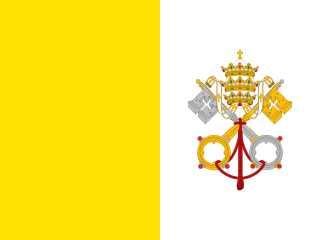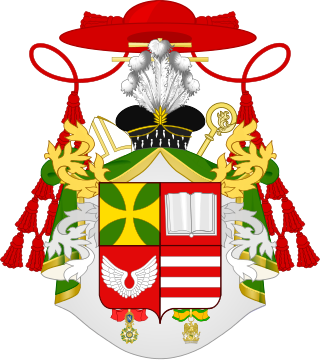
Ancona is a city and a seaport in the Marche region in central Italy, with a population of around 101,997 as of 2015. Ancona is the capital of the province of Ancona and of the region. The city is located 280 km (170 mi) northeast of Rome, on the Adriatic Sea, between the slopes of the two extremities of the promontory of Monte Conero, Monte Astagno and Monte Guasco.

The Papal States, officially the State of the Church, were a series of territories in the Italian Peninsula under the direct sovereign rule of the pope from 756 until 1870. They were among the major states of Italy from the 8th century until the unification of Italy, between 1859 and 1870.

The Holy See exercised political and secular influence, as distinguished from its spiritual and pastoral activity, while the pope ruled the Papal States in central Italy.

Marche is one of the twenty regions of Italy. The region is located in the central area of the country, and has a population of about 1.5 million people, being the thirteenth largest region in the country by number of inhabitants. The region's capital and largest city is Ancona.

The Roman Republic was a sister republic of the First French Republic. It was proclaimed on 15 February 1798 after Louis-Alexandre Berthier, a general of the French Revolutionary Army under the rule of Napoleon Bonaparte, had occupied the city of Rome on 10 February. It was led by a Directory of five men and comprised territory conquered from the Papal States. Pope Pius VI was exiled to France and died there in August 1799. The Roman Republic immediately took control of the other two former-papal revolutionary administrations, the Tiberina Republic and the Anconine Republic. The Roman Republic proved short-lived, as Neapolitan troops restored the Papal States in October 1799.

The papal conclave that followed the death of Pius VI on 29 August 1799 lasted from 30 November 1799 to 14 March 1800 and led to the selection of Cardinal Barnaba Chiaramonti, who took the name Pius VII. This conclave was held in Venice and was the last to take place outside Rome. This period was marked by uncertainty for the papacy and the Roman Catholic Church following the invasion of the Papal States and abduction of Pius VI under the French Directory.

Giovanni Battista Caprara Montecuccoli was an Italian statesman and Cardinal and archbishop of Milan from 1802 to 1810. As a papal diplomat he served in the embassies in Cologne, Lausanne, and Vienna. As Legate of Pius VII in France, he implemented the Concordat of 1801, and negotiated with the Emperor Napoleon over the matter of appointments to the restored hierarchy in France. He crowned Napoleon as King of Italy in Milan in 1805.

The Roman scudo was the currency of the Papal States until 1866. It was subdivided into 100 baiocchi, each of 5 quattrini. Other denominations included the grosso of 5 baiocchi, the carlino of 7+1⁄2 baiocchi, the giulio and paoli both of 10 baiocchi, the testone of 30 baiocchi and the doppia of 3 scudi.
The Treaty of Tolentino was a peace treaty between Revolutionary France and the Papal States, signed on 19 February 1797 and imposing terms of surrender on the Papal side. The signatories for France were the French Directory's Ambassador to the Holy See, François Cacault, and the rising General Napoleon Bonaparte and opposite them four representatives of Pius VI's Curia.

The March of Ancona was a frontier march centred on the city of Ancona and later Fermo then Macerata in the Middle Ages. Its name is preserved as an Italian region today, the Marche, and it corresponds to almost the entire modern region and not just the Province of Ancona.

Arcevia is a comune in the province of Ancona of the region of Marche, central-eastern Italy.

The maritime republics, also called merchant republics, were thalassocratic city-states of the Mediterranean Basin during the Middle Ages. Being a significant presence in Italy in the Middle Ages, four of them have had their coats of arms inserted in the flag of the Italian Navy since 1947: Venice, Genoa, Pisa, and Amalfi; the other republics are: Ragusa, Gaeta, Ancona, and the little Noli.
The modern history of the papacy is shaped by the two largest dispossessions of papal property in its history, stemming from the French Revolution and its spread to Europe, including Italy.

The Battle of Faenza, also known as the Battle of Castel Bolognese on February 3, 1797 saw a 7,000 troops from the Papal Army commanded by Michelangelo Alessandro Colli-Marchi facing 9,000 troops from the French Army under the command of Claude Victor-Perrin. The veteran French troops quickly overran the Papal army, inflicting disproportionate casualties. The town of Castel Bolognese was located on the banks of the Senio River 40 kilometres (25 mi) southeast of Bologna, and the city of Faenza was also nearby. The action took place during the War of the First Coalition, as part of the French Revolutionary Wars.

The Republic of Ancona was a medieval commune and maritime republic notable for its economic development and maritime trade, particularly with the Byzantine Empire and Eastern Mediterranean, although somewhat confined by Venetian supremacy on the sea. It enjoyed excellent relations with the Kingdom of Hungary, was an ally of the Republic of Ragusa, and maintained good relations with the Turks. All these relationships enabled it to serve as central Italy's gateway to the Orient.
The Armistice of Bologna was a treaty signed between the Papal States and the French First Republic on 23 June 1796. It resulted in a ceasefire between the two parties that was intended to last until a permanent peace treaty could be signed. The terms of the armistice included the payment of 15 million livres in cash in addition to goods and works of art to the French and significant territorial reductions. A temporary Austrian victory against the French at the Siege of Mantua persuaded Pope Pius VI to renounce the armistice in September 1796. The French subsequently invaded the Papal States and enforced the terms of the armistice.
The following is a timeline of the history of the city of Ancona in the Marche region of Italy.

The flag of Marche is one of the official symbols of the region of Marche, Italy. Like many Italian regional flags, it was adopted on 4 November 1995 for Armed Forces Day of Italy. In absence of a law on the subject, the regional emblem that had been adopted on 15 March 1980 was simply inserted on a white background.

The fall of the Republic of Venice was a series of events that culminated on 12 May 1797 in the dissolution and dismemberment of the Republic of Venice at the hands of Napoleon Bonaparte and Habsburg Austria.

















